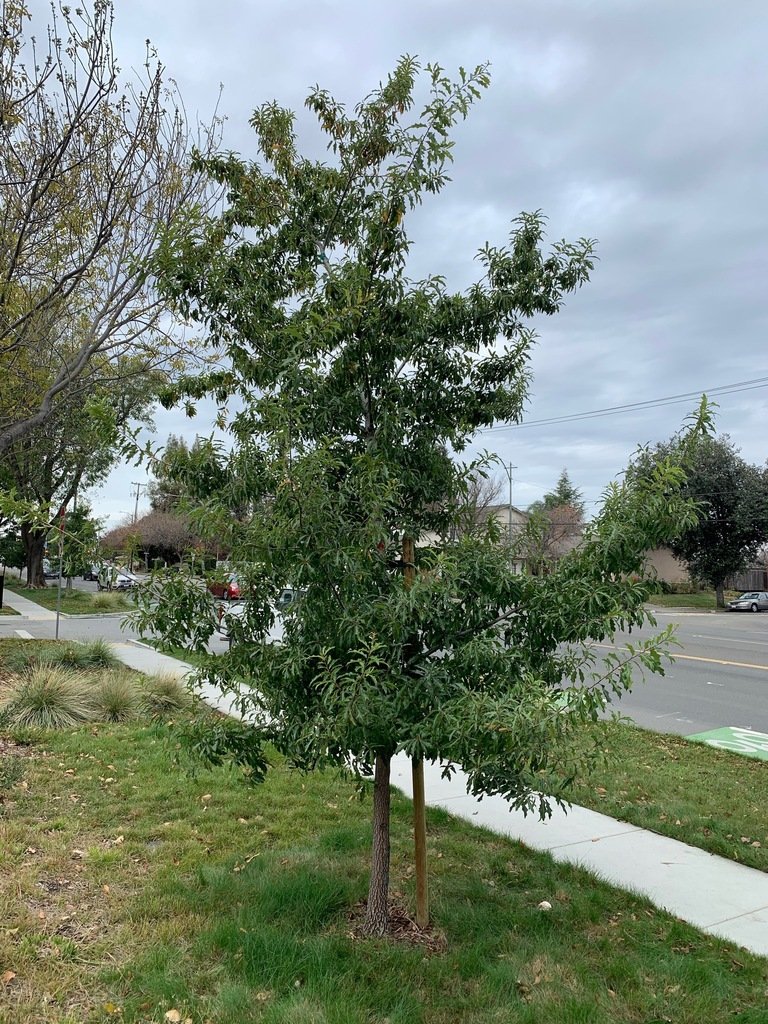Chisos Red Oak
Quercus gravesii
Family: Fagaceae
OTHER NAMES
Graves oak, mountain red oak
CHARACTERISTICS
This tree is very similar to the Texas red oak (Quercus buckleyi) but is slightly smaller and holds its leaves longer (they drop just before the new ones emerge). Grows to 40’ tall but often found smaller in our region. Red fall color.
LANDSCAPE USE
Small to medium shade tree.
GROWING CONDITIONS
AN EXPLANATION OF TERMS USED
SUN full to part sun
WATER moderate
SOIL not picky, but well-drained
HARDINESS hardy to about 0°F
BASIN high zone
CONTAINER does moderately well in containers but will not attain full size
NUTRITION low
MAINTENANCE very little
Photo of young plant in cultivation by Dave Muffly, iNaturalist
Quercus gravesii on Ladybird Johnson Wildflower Center
ECOLOGY
Flowers in spring with inconspicuous, wind-pollinated flowers. Acorns ripen in fall. Oaks are wildlife keystone species hosting a mind-boggling number of insects. This brings in a vast array of substrate-insectivorous birds (birds that spend their time on these trees eating the insects). The acorns are important food for many birds and mammals (and some species eaten by people). The trees also provide important habitat for many birds and mammals. Almost all the oaks host a multitude of moths and butterflies including the following species:
Mexican-M Hairstreak (Parrhasius moctezuma)
Arizona Sister (Adelpha eulalia)
Short-tailed Skipper (Zestusa dorus)
Arizona Dull Firetip (Apyrrothrix araxes ssp. arizonae)
Burgess’s Sleepy Duskywing (Erynnis brizo ssp. burgessi)
Clitus Duskywing (Erynnis juvenalis ssp. clitus)
Meridian duskywing (Erynnis meridianus ssp. meridianus)
Scudder's Duskywing (Erynnis scudderi)
Mournful Duskywing (Erynnis tristis)
Oaks also host a diversity of insects that cause growths called “galls”. Galls are protective nests for the larvae of various insects (mostly tiny stingless wasps) to develop protected from pests. The have a diversity of shapes from giant ball-like growths, to small growths, on leaves or young stems. These galls do not harm healthy trees. Emory oaks that grow in riparian zones and get really tall are a favorite nesting site for owls and other raptors.
Oaks attract numerous other insects which, in turn, attracts canopy-gleaning birds.
ETHNOBOTANY
Probably used like Quercus buckleyi.
NATURAL DISTRIBUTION
Chisos Red Oak grows west of the Pecos River in high canyons of the Chisos, Davis, Del Norte and Glass Mountains in west Texas. It goes south into Mexico as far as the state of Tamaulipas. It generally grows above 5,000 feet, on either igneous or limestone soils.
TAXONOMY AND NAME
This plant is in the family Fagaceae, the beech family. There are 627 accepted species in the genus Quercus widely distributed in the northern hemisphere.
The genus "Quercus" is from Latin, meaning "oak" while the species “gravesii” is name for George Graves (1784–1839) was the author of a comprehensive instruction guidebook for beginners in natural history at a time when there was a growing interest in collecting animal, plant and geological specimens.TAXONOMY AND NAME
This species, like many Texas/NE Mexico oaks, is very upright growing, contrasted to most of the Arizona species which are more shrubby. Photo by Antonio Sarabia, iNaturalist
Foliage detail photo by Chuck Sexton, iNaturalist
Newly emerging foliage and flowers in spring. Photo by Pauline Singleton, iNaturalist
Developing acorn, photo by Sequoia Janirella Wrens, iNaturalist
Fall color, photo by m3thyl, iNaturalist






